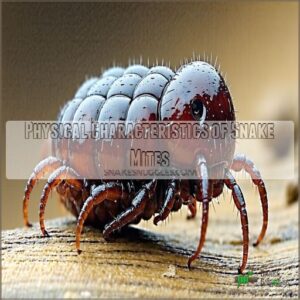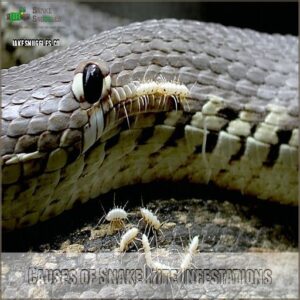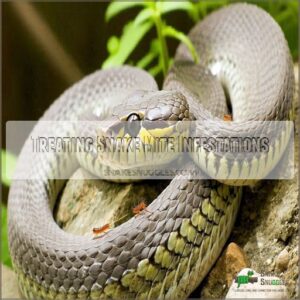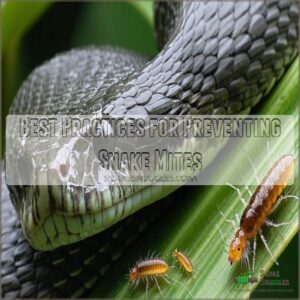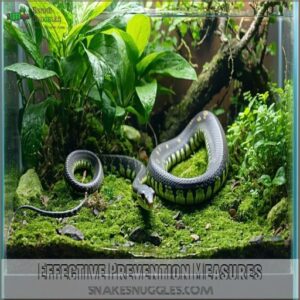This site is supported by our readers. We may earn a commission, at no cost to you, if you purchase through links.
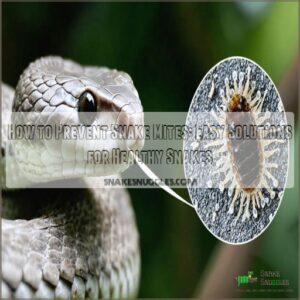 Don’t let snake mites ruin your slithery friend’s health! The best way to prevent these pesky parasites is by keeping things squeaky clean.
Don’t let snake mites ruin your slithery friend’s health! The best way to prevent these pesky parasites is by keeping things squeaky clean.
First, quarantine any new snakes for 2-3 months to stop mites from spreading.
Then, regularly inspect your snake and its home, and clean the enclosure daily with a diluted bleach solution. Use mite-resistant substrates and decor, and be extra careful to avoid cross-contamination.
With a little vigilance, you can keep your snake happy and healthy, free from those nasty mites. Curious to learn more prevention tips? Keep reading to discover how to create a snake mite-free oasis!
Table Of Contents
- Key Takeaways
- What Are Snake Mites?
- Causes of Snake Mite Infestations
- Identifying Snake Mite Infestations
- Treating Snake Mite Infestations
- Best Practices for Preventing Snake Mites
- Effective Prevention Measures
- Long-Term Prevention Strategies
- Frequently Asked Questions (FAQs)
- How do you keep mites off a snake?
- How do you treat snake mites without a vet visit?
- Why is it important to treat a snake mite infestation early?
- Are snake mites hard to get rid of?
- How long does it take to get rid of snake mites?
- How Long Does It Take for Snake Mites to Reproduce?
- How Often Should I Check for Snake Mites?
- What Other Animals Are at Risk of Snake Mite Infestation?
- How Long Should I Quarantine a New Reptile?
- Is There a Way to Prevent Snake Mites From Returning?
- Conclusion
Key Takeaways
Here are four key takeaways about the best way to prevent snake mites:
- Quarantine any new snakes for 2-3 months to stop mites from spreading to your other pets.
- Regularly inspect your snake and its home, and clean the enclosure daily with a diluted bleach solution to eliminate mite hiding spots.
- Use mite-resistant substrates and decor, and be extra careful to avoid cross-contamination when handling different reptiles.
- Spot mite infestations early by watching for visible signs like tiny moving bugs and behavioral changes in your snake, such as lethargy or excessive rubbing.
What Are Snake Mites?
If you’ve noticed tiny bugs crawling on your beloved snake, don’t worry – those are probably just snake mites.
These tiny parasites may seem pesky, but with the right steps, you can get rid of them and keep your reptile pal healthy.
Physical Characteristics of Snake Mites
Snake mites are tiny, black or reddish-gray bugs that feed on snake blood.
You can spot them as small moving dots on your snake’s skin, especially near the eyes, ears, and vent.
They go through a life cycle of egg, larva, nymph, and adult, causing skin irritation and disease.
These parasites are a common problem for reptile owners, but understanding their physical traits is the first step to keeping them at bay.
- Snake mites are visible to the naked eye
- They’ve oval-shaped bodies and six legs
- Their small size makes them hard to detect initially
Life Cycle and Reproduction
Mites lay their eggs in cracks and crevices, which hatch into larvae within a few days.
These larvae then molt into nymphs, which eventually become fully-grown adults.
Mites can reproduce rapidly, with females laying dozens of eggs at a time.
Effective mite prevention products can help stop mites from multiplying.
Understanding this life cycle is key to stopping mite infestations before they spiral out of control.
Causes of Snake Mite Infestations
Where do those pesky snake mites come from?
You’d be surprised – they can hitch a ride on wild-caught snakes or be introduced through cross-contamination from infected reptiles.
And if your snake’s home isn’t kept spic and span, well, that’s the perfect breeding ground for these unwelcome guests.
Wild-Caught Snakes and Mites
Wild-caught snakes are a common source of snake mites.
These reptiles often harbor mite infestations that can easily spread to your other pets.
Start by quarantining any new snakes for 2-3 months before introducing them to your collection.
This helps make sure you don’t inadvertently invite mites into your home.
Cross-Contamination From Infected Reptiles
Handling reptiles from pet stores or breeding facilities can be dicey; those tiny vampire-like mites often hitch rides. When snakes touch or share space, mites party like it’s the Super Bowl of infestation.
- New roommates: keep new snakes solo in quarantine.
- Mite highways: wash hands after handling different reptiles.
- Reptile roommates: don’t share accessories.
Poor Hygiene and Unhygienic Enclosures
Poor hygiene and neglecting to properly maintain your snake’s enclosure can invite unwanted guests – snake mites.
These pesky parasites thrive in dirty, cramped habitats.
But don’t worry, a little cleaning goes a long way!
Regularly disinfect the enclosure, replace contaminated substrate, and always wash your hands before handling your scaly friend.
| Action | Recommendation |
|---|---|
| Enclosure Cleaning | Hot water (122°F+) and 3% bleach solution |
| Substrate Replacement | Use fresh, mite-free substrate |
| Hand Washing | Wash thoroughly before and after handling |
By keeping your snake’s home spick and span, you can shut the door on mite infestations for good.
A clean, comfortable environment means a happy, healthy snake!
Contaminated Substrate and Accessories
Contaminated substrate and accessories can be a sneaky source of snake mites.
Mites can hide in crevices and thrive in dirty enclosures.
Regularly swap out substrate, disinfect hides, and use mite-resistant materials like aspen shavings.
Keep everything squeaky clean to deny those pesky mites a cozy home for their growing family.
Identifying Snake Mite Infestations
Wondering if your slithery friend has snake mites?
Keep an eye out for those pesky little critters – you’ll spot them as small black, red, or grey bugs hanging around your snake’s thin-skinned areas.
And if your snake starts acting lethargic or rubbing up against things, that could be another sign of a mite infestation.
Visible Signs of Mites on Snakes
Visible mites on your snake are one of the clearest signs of an infestation.
Look for tiny black, red, or grey bugs clustered around the eyes, ears, and skin folds.
You may also spot tiny black dots moving on the snake’s body or shed skin.
Stay vigilant – catching mites early is key to keeping your scaly friend healthy.
Behavioral Changes in Infested Snakes
If your snake seems more sluggish or lethargic than usual, it may be a sign of a mite infestation.
You may also notice your snake excessively rubbing against surfaces, losing its appetite, or appearing more irritable.
Don’t wait – check for other telltale signs like your snake soaking abnormally in its water dish.
Other Common Signs of Mite Infestations
Beyond the visual clues, snake mites can cause a range of troubling symptoms.
Look out for skin irritation, weight loss, lethargy, shedding issues, and even respiratory problems.
These sneaky parasites can wreak havoc on your scaly friend’s health if left unchecked.
To prevent these issues, consider using a reliable snake mite spray.
Stay vigilant and act fast if you spot any worrying signs.
Treating Snake Mite Infestations
Dealing with a snake mite infestation? Don’t worry, we’ve got your back!
First, you’ll need to thoroughly clean and disinfect the snake’s enclosure.
Then treat the snake itself with a Fipronil spray – it’s the best way to get rid of those pesky mites for good.
Cleaning and Disinfecting Enclosures
Spying mites in your snake’s habitat is less fun than a root canal.
Now, let’s talk enclosure sterilization. You won’t need a magic wand, just some elbow grease.
To prevent re-infestation, consider using snake mite sprays found in stores like reptile mite sprays.
Use hot water to clean thoroughly. Mix safe disinfectants. Clean regularly for perfect snake hygiene.
De-stress by knowing your mite prevention plan is rock solid.
Treating Snakes With Fipronil Spray
When treating an active snake mite infestation, a single application of a Fipronil-based spray can be highly effective.
Gently apply the spray directly to your snake’s skin, avoiding the eyes and any open wounds.
Follow all safety precautions on the product label, and consult your veterinarian if you have any concerns about using Fipronil on younger or more delicate reptiles.
Removing and Replacing Contaminated Substrate
Once you’ve thoroughly cleaned the enclosure, it’s time to safely remove any contaminated substrate.
Discard all old substrate and hiding spots – you don’t want to risk reintroducing mites.
Sterilize the enclosure with hot water and disinfectant, then add fresh, mite-free substrate. This guarantees a clean, healthy environment for your snake.
Best Practices for Preventing Snake Mites
Preventing snake mites is a breeze with the right steps.
Quarantine new reptiles, maintain strict enclosure hygiene.
And regularly inspect for signs of mites to keep your slithery friends happy and healthy.
Quarantine Procedures for New Reptiles
Welcoming a new reptile is exciting, but without proper quarantine, your enthusiasm might invite unwanted guests—mites.
Follow these steps for successful new reptile acclimation:
- Set up a quarantine room: Use a separate, secure space.
- Monitor daily: Check for signs of stress and parasites.
- Limit handling: Allow adjustment to minimize reptile stress.
These steps guarantee a healthy integration.
Maintaining Strict Hygiene in Enclosures
Keeping your snake’s home spotless is vital.
Wipe down the enclosure daily with a diluted bleach solution.
Use mite-resistant substrate and décor that can be fully disinfected.
Maintain ideal humidity levels to discourage mites, and guarantee proper airflow.
Taking these proactive steps safeguards your slithery friend from pesky infestations.
Regular Inspections for Mites
Regularly inspecting your snake’s enclosure is essential for quickly detecting and addressing any mite issues, as these parasites can cause stress, discomfort, and even transmit diseases between snakes.
Keep an eye out for tiny black dots moving around, and use a magnifying glass if needed.
Be aware of snake mites symptoms like lethargy and loss of appetite.
At the first sign of mites, spring into action to prevent a full-blown infestation.
Regularly checking is your best defense against these pesky parasites.
Effective Prevention Measures
Keeping your snake’s home squeaky clean is key to preventing pesky mites. You’ll also want to avoid bringing new critters into the mix – quarantining new reptiles is a must.
Mite-Free Substrate and Accessories
Using the right substrate and accessories is essential to preventing snake mites.
Look for mite-resistant options like aspen shavings or cypress mulch, and consider a snake housing substrate that’s safe and easy to clean.
Avoid substrates that retain moisture, as mites thrive in damp environments.
Whenever possible, choose washable, easy-to-disinfect accessories to eliminate mite hideouts and quickly address any infestations.
Avoiding Cross-Contamination
To dodge those pesky mites, imagine enclosures as tiny castles needing their own moats.
By preventing cross-contamination, you’re stepping up your snake mite control game.
Keep these important points in mind:
- Mite-free handling: Use gloves.
- Reptile quarantine: Isolate newcomers.
- Mite-free supplies: Always sanitize.
- Separate enclosures: Avoid roommate drama.
This way, you’ll boost your snake mite prevention efforts!
Reducing Human Transfer of Mites
Don’t let your hands or clothes become snake mite shuttles.
Handwash thoroughly before and after handling snakes.
Consider changing into separate cleaning clothes when working in enclosures.
Disinfect tools and dedicate specific gloves solely for snake care.
Maintaining dedicated workspaces also helps halt the march of these tiny pests.
Long-Term Prevention Strategies
Staying vigilant and on top of enclosure hygiene is essential for long-term snake mite prevention.
You’ll also want to implement strict quarantine protocols for any new reptiles to keep your beloved snakes safe and healthy.
Monitoring for Mites and Early Detection
Spotting snake mites early keeps your slithery pals happy and healthy.
Regular visual checks can catch early signs of infestation.
Watch for:
- Mite behavior: Tiny black dots moving on your snake’s skin.
- Substrate analysis: Look for mites hiding in the bedding.
- Snake’s actions: Increased rubbing or soaking.
Vigilance in monitoring helps in effective snake mite prevention.
Maintaining Clean and Hygienic Enclosures
Regularly disinfect surfaces using a 3% bleach solution and hot water.
Replace contaminated substrate promptly.
Maintain ideal humidity and ventilation to discourage mite infestations.
With a little diligence, you can create a clean, safe habitat for your slithery friend. This will help keep your snake’s enclosure spotless.
Implementing Quarantine Protocols for New Reptiles
Quarantining new reptiles for 2-3 months is essential to prevent snake mite infestations.
Set up a separate enclosure or room, and closely monitor their health.
After quarantine, thoroughly clean and disinfect the enclosure before introducing them to your main collection.
This simple precaution can save your snakes from a costly and frustrating mite problem.
Frequently Asked Questions (FAQs)
How do you keep mites off a snake?
Snake mites can be a real pain, huh?
But don’t worry, keeping those pesky critters at bay is easier than you think.
Just give your snake’s pad a deep clean, and you’ll be mite-free in no time.
Easy as pie!
How do you treat snake mites without a vet visit?
Eliminate their hiding spots and stop them from spreading by thoroughly cleaning the snake’s enclosure.
Use an insecticide spray specially formulated for reptiles to kill mites on contact.
Monitor your snake closely for any lingering issues.
Why is it important to treat a snake mite infestation early?
Treating a snake mite infestation early is very important, as mites can quickly reproduce and cause serious harm to your beloved pet.
Left untreated, mites may lead to anemia, skin infections, and even death.
Act now to keep your snake healthy and happy!
Are snake mites hard to get rid of?
Getting rid of snake mites can be tricky. A thorough cleaning and appropriate mite treatments are essential. Persistence is key; it might take a few tries to win this battle.
How long does it take to get rid of snake mites?
I hear you – getting rid of snake mites can be a real pain.
But the good news is, with the right approach, you can typically banish them within 2-3 weeks.
The key is being thorough in treating both your snake and its habitat.
How Long Does It Take for Snake Mites to Reproduce?
Snake mites reproduce rapidly, with eggs hatching in 1-4 days and developing into adults in about 10 days under ideal conditions.
Keep a vigilant eye—you might just catch them before they multiply!
How Often Should I Check for Snake Mites?
Peeking regularly into your snake’s cozy home is like checking for hidden treasures – you never know what delightful (or not-so-delightful) discoveries await.
Make it a weekly routine to guarantee your scaly friend stays mite-free and thriving.
What Other Animals Are at Risk of Snake Mite Infestation?
While snakes are the primary host, guinea pigs, hamsters, and other small rodents can also fall victim to snake mite infestations.
Regular enclosure cleaning and quarantining new pets are essential to prevent spread across your furry and scaly companions.
How Long Should I Quarantine a New Reptile?
You should quarantine any new reptile for 2-3 months before introducing it to your existing collection.
This gives you time to monitor for signs of mites and treat the new arrival if needed.
Is There a Way to Prevent Snake Mites From Returning?
Snake mites are crafty little buggers, but with a savvy game plan, you can wave them goodbye for good.
Stay on top of enclosure cleanliness and check your scaly friends regularly.
Quarantine newcomers – easy-peasy, no mite-y!
Conclusion
With a little diligence in preventing snake mites, you can guarantee your slithery friend stays happy and healthy.
By quarantining new snakes, maintaining spotless enclosures, and regularly inspecting for signs of mites, you’ll create a mite-free oasis for your scaly companion.
Don’t let these pesky parasites ruin your snake’s day – follow these proven prevention tips to keep your reptile resilient!

